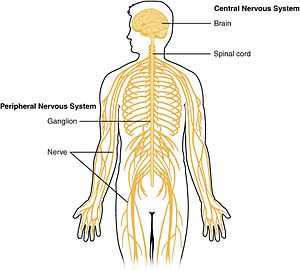
Back Sentrale senuweestelsel Afrikaans جهاز عصبي مركزي Arabic ܬܘܩܢ ܓܝܕܝܐ ܩܢܛܪܘܢܝܐ ARC جهاز عصبى مركزى ARZ কেন্দ্ৰীয় স্নায়ু তন্ত্ৰ Assamese Sistema nerviosu central AST Mərkəzi sinir sistemi Azerbaijani Цэнтральная нервовая сістэма Byelorussian Цэнтральная нэрвовая сыстэма BE-X-OLD Централна нервна система Bulgarian
| Central nervous system | |
|---|---|
 Schematic diagram showing the central nervous system in yellow, peripheral in orange | |
| Details | |
| Lymph | 224 |
| Identifiers | |
| Latin | systema nervosum centrale pars centralis systematis nervosi[1] |
| Acronym(s) | CNS |
| MeSH | D002490 |
| TA98 | A14.1.00.001 |
| TA2 | 5364 |
| FMA | 55675 |
| Anatomical terminology | |
The central nervous system (CNS) is the part of the nervous system consisting primarily of the brain and spinal cord. The CNS is so named because the brain integrates the received information and coordinates and influences the activity of all parts of the bodies of bilaterally symmetric and triploblastic animals—that is, all multicellular animals except sponges and diploblasts. It is a structure composed of nervous tissue positioned along the rostral (nose end) to caudal (tail end) axis of the body and may have an enlarged section at the rostral end which is a brain. Only arthropods, cephalopods and vertebrates have a true brain, though precursor structures exist in onychophorans, gastropods and lancelets.
The rest of this article exclusively discusses the vertebrate central nervous system, which is radically distinct from all other animals.
- ^ Farlex Partner Medical Dictionary, Farlex 2012.